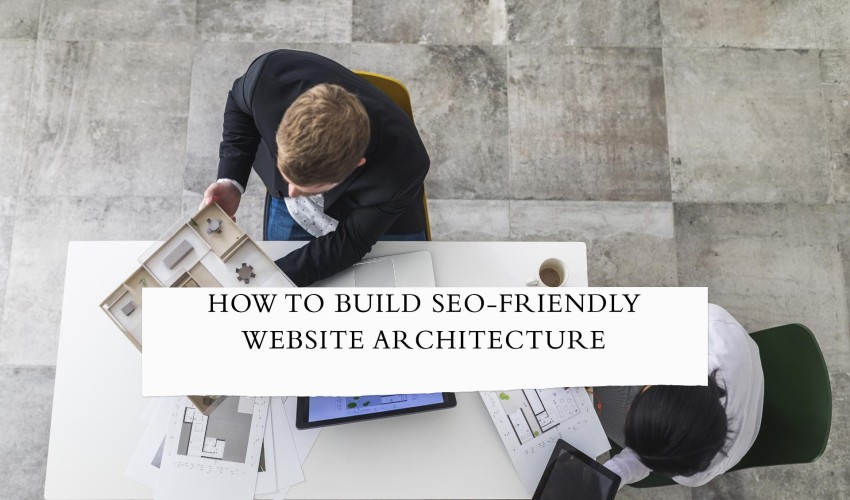How to Build SEO-Friendly Website Architecture

In today's digital age, having an online presence is crucial for the success of any business. However, merely having a website is not enough; it needs to be optimized for search engines to ensure maximum visibility. In this article, we'll explore the essential elements of building an SEO-friendly website architecture and how it contributes to online success.
In the ever-expanding digital landscape, SEO-friendly website architecture is the cornerstone of online visibility. It involves creating a website structure and design that not only appeals to users but also aligns with search engine algorithms. A well-designed website not only attracts more organic traffic but also provides a better user experience, ultimately contributing to higher rankings on search engine results pages (SERPs).
Key Components of SEO-Friendly Website Architecture
A. URL Structure
The URL structure plays a vital role in both user experience and SEO. Clean and organized URLs not only make it easier for visitors to navigate your site but also help search engines understand the content. We'll delve into the importance of URL optimization and provide best practices for creating SEO-friendly URLs.
Navigation and Site Structure
Creating a logical and user-friendly site structure is crucial for retaining visitors and improving SEO. Clear navigation ensures that users can easily find the information they are looking for, while search engines can crawl and index your site efficiently. This section will outline strategies for establishing an intuitive site structure that benefits both users and search engines.
Mobile Responsiveness
With the increasing use of mobile devices, having a mobile-friendly Best website designig company is no longer optional�it's a necessity. We'll discuss the significance of mobile-friendly design in SEO and provide tips for optimizing websites to ensure a seamless experience across various devices.
Keyword Research and Implementation
Effective keyword research is the foundation of SEO-friendly website architecture. This section will guide readers on conducting thorough keyword research and integrating these keywords strategically into website content and meta tags. We'll emphasize the importance of avoiding keyword stuffing to maintain a natural and engaging user experience.
Page Speed Optimization
Page speed directly influences user satisfaction and SEO rankings. In this section, we'll explore the impact of page speed on SEO and provide practical techniques for improving website loading times. Additionally, we'll discuss the importance of optimizing images and multimedia content for faster loading.
XML Sitemap and Robots.txt
Creating and maintaining an XML sitemap is essential for helping search engines understand the structure of your website desigimg company. Similarly, a well-structured robots.txt file guides search engine crawlers to index the right pages. This section will provide insights into creating and updating XML sitemaps and robots.txt files for optimal SEO performance.
Content Structure and SEO
High-quality, relevant, and engaging content is a crucial factor in SEO success. This section will delve into the importance of heading tags, meta descriptions, and alt attributes in optimizing content for search engines. Striking a balance between creating content for users and satisfying search engine algorithms is key to long-term SEO success.
Backlink Structure
Backlinks remain a significant factor in search engine algorithms. This section will discuss the role of backlinks in SEO, strategies for building high-quality backlinks, and the importance of monitoring and disavowing toxic backlinks.
Technical SEO Considerations
Technical SEO involves addressing issues such as canonicalization, duplicate content, and implementing structured data markup (Schema.org). We'll explore these technical aspects and provide insights into optimizing web design company for local SEO and voice search.
Monitoring and Optimization
Building an SEO-friendly website is not a set-it-and-forget-it endeavor. Continuous monitoring and optimization are crucial for adapting to changing search engine algorithms and user behaviors. In this section, we'll emphasize the importance of regularly reviewing website performance metrics, staying updated on industry trends, and making necessary adjustments to maintain optimal SEO.
Advanced SEO Strategies
Delve into advanced SEO strategies that go beyond the basics. This section can cover topics such as advanced keyword research techniques, leveraging long-tail keywords, and utilizing schema markup to enhance rich snippets. By implementing these advanced strategies, businesses can gain a competitive edge and further boost their search engine rankings.
Local SEO Optimization
For businesses targeting a local audience, optimizing for local search is paramount. Explore the nuances of local SEO, including creating a Google My Business profile, obtaining online reviews, and optimizing location-based keywords. This section will guide readers on how to enhance their online visibility within specific geographic areas.
Voice Search Optimization
With the rise of voice-activated devices, optimizing for voice search is becoming increasingly important. Discuss the impact of voice search on SEO and provide actionable tips for adapting website content to cater to voice queries. This section will help businesses stay ahead in the evolving landscape of search engine optimization.
Case Studies and Success Stories
Illustrate the effectiveness of SEO-friendly website architecture through real-world case studies and success stories. Showcase businesses that have experienced significant improvements in organic traffic, rankings, and overall online visibility after implementing the discussed strategies. This section adds a practical dimension, reinforcing the value of SEO practices.
Choosing the Right Website Design Partner
Highlight the significance of partnering with a reputable website designing company. Discuss the criteria businesses should consider when selecting a web design agency, such as experience, expertise, and a proven track record in creating SEO-friendly websites. Emphasize how the right design partner can contribute to the overall success of an online presence.
In conclusion, building an SEO-friendly website architecture is not a one-time task but an ongoing process. By implementing the discussed strategies, businesses can enhance their online presence, attract more organic traffic, and achieve higher rankings on search engine results pages. For professional assistance in creating SEO-friendly websites, contact "BRAND," your go-to partner for comprehensive website designing services and optimization services.




